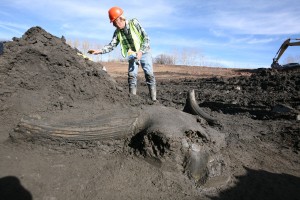Scientists digging into the peat below Ziegler Reservoir at Snowmass Village, Colorado, found something like an Ice Age zoo last fall. Now, as they prepare to start digging again next month, they also have a puzzle.
Researchers are hunched over in labs piecing together fragments of mastodon skulls and ancient deer antlers. But scientists are also piecing together bigger questions. When did these animals die? Why there? And more importantly, what can they tell us about climate change – then and now?
“Who amongst us would survive if we didn’t understand our personal history, where we came from?” asks Kirk Johnson, chief curator at the Denver Museum of Nature and Science, who is overseeing the project. “The same applies to our climate’s history.”
The accidental findings at Snowmass Village were so incredible in so many ways, it’s hard for Johnson to hold back his enthusiasm.
First, there’s the Noah’s ark of species they found: mammoths, mastodons, ancient deer and bison, a Jefferson ground sloth, salamanders, beetles, snails, bugs and plants. Some of these are first-evers. The first ever mastodon skull found in Colorado. The first-ever Jefferson ground sloth. The deer could represent a new species.
Then there’s the quantity: eight to 10 mastodons; four mammoths; deer and bison, two by two.
Then there’s the quality. Some of the mammoth and mastodon bones still have DNA on them. Some of the plant material is still green. It was all packed in water, free of oxygen, impeccably preserved.
“I’ve used the metaphor of a Tupperware container or a Ziplock bag,” Johnson says. “(The site) had a 5-foot layer of clay, which I think just sealed it.”
These remarkable finds came from just 18 days of excavation.
On May 15, a squadron of scientists plan to return for another 17 days to see what else they find. A saber-tooth cat maybe? A dire wolf? Horses? Camels? Yes, Johnson says, camels were common critters in Ice Age Colorado.
“A giant Ice Age moose I’d love to find,” he says. “It’s a nice menu of opportunity and we will just see what we get when we get there.”
The find was an auspicious accident. Construction crews were bulldozing the area to enlarge a reservoir for the Snowmass Water and Sanitation District when worker Jesse Steele noticed something unusual last October. It was, it turned out, a juvenile Columbian mammoth.
Museum scientists descended 19 days later. More than 60 staff and trained volunteers put in 3,600 hours of fieldwork. (See a timeline of the excavationhere.) They were stunned at what awaited them. Mammoths and mastodons of all ages and both genders, and species that may have lived thousands – even 100,000 – years apart.
“This site is the best high-elevation Ice Age site in North America,” Johnson says. “It has a great diversity of large mammal fossils and they come from different eras.”
More important than the species themselves, though, may be what the dig can say about the Rockies during the Ice Age.
Because of the site’s position at 8,875 feet, it had an unusually good view of the changing landscape over the millennia. During warmer times, it was below treeline. During cooler times, it was above it.
“The site is just the right elevation to watch the treeline come and go,” Johnson says, “and that will give us a beautiful little climate record for Colorado, which we’ve never had before.”
Mostly, our sense of ancient fluctuations in the climate have come from remote places, like Antarctica or Greenland. But those may not provide the best record for places like Colorado, Johnson says.
“What you really want is a more local story,” he says, and this dig may provide that.
Climate is important everywhere, but it’s central to the story of the West, Johnson says. Never mind the current battles about climate change. Westerners depend on winter snows for summer water. Ancient Puebloans suffered through drought.
“It’s all part of understanding what the sage of the American West is,” Johnson says.
The operation became named, appropriately, the Snowmastodon Project, and that first mammoth to pop out was dubbed Snowy in a museum contest. Over the ensuing weeks, workers uncovered 600 bones and pieces, 15 tusks, two tusk tips, hundreds of tusk fragments and more than 130 samples of peat, wood, leaves, rocks and invertebrates.
They found seeds, cones, pollen and bits of white spruce and subalpine fir. Some of the wood they found had been gnawed by Ice Age beavers.
All of this was deposited in an Ice Age lake. Just how old the lake is, though, has been tough to determine. It’s at least 45,000 years old, too old for carbon dating, and at most 150,000 years old, when glaciers rolled in and created the moraines that formed the lake.
The variety of fossils at different levels suggests the creatures found there died over a long period of time. Mammoths and mastodons, for instance, shared the earth at the same time, Johnson says, but not the same places. Mammoths liked grasslands. Mastodons preferred forests.
On May 15, a team of 34 scientific experts from 15 institutions in the United States, Canada and England plan to return to Ziegler Reservoir for more digging in a flurry that will dwarf the last effort. Some 45 people plan to work each day – the equivalent of 2,300 work days – to unearth any fossils they find so the Snowmass Water and Sanitation crew can finish its dam on time.
Since it’s a dam, Johnson says, if crews need to go back in the future, access shouldn’t be too hard. It’s just a matter of waiting for a dry year to drain the reservoir and start digging again, he says.


